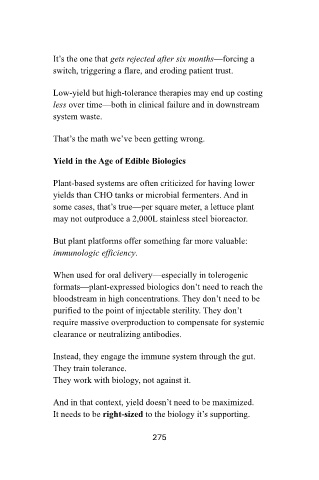Page 277 - Binder2
P. 277
It’s the one that gets rejected after six months—forcing a
switch, triggering a flare, and eroding patient trust.
Low-yield but high-tolerance therapies may end up costing
less over time—both in clinical failure and in downstream
system waste.
That’s the math we’ve been getting wrong.
Yield in the Age of Edible Biologics
Plant-based systems are often criticized for having lower
yields than CHO tanks or microbial fermenters. And in
some cases, that’s true—per square meter, a lettuce plant
may not outproduce a 2,000L stainless steel bioreactor.
But plant platforms offer something far more valuable:
immunologic efficiency.
When used for oral delivery—especially in tolerogenic
formats—plant-expressed biologics don’t need to reach the
bloodstream in high concentrations. They don’t need to be
purified to the point of injectable sterility. They don’t
require massive overproduction to compensate for systemic
clearance or neutralizing antibodies.
Instead, they engage the immune system through the gut.
They train tolerance.
They work with biology, not against it.
And in that context, yield doesn’t need to be maximized.
It needs to be right-sized to the biology it’s supporting.
275

